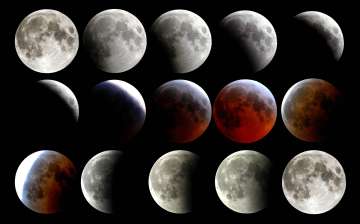The final eclipse of the current cycle which saw a lunar eclipse on June 5 and then the historic Solar Eclipse on June 21, will take place day after tomorrow (July 5). Lunar eclipses can be visible from everywhere on the night side of the Earth, if the sky is clear. From some places, the entire eclipse will be visible, while in other areas the Moon will rise or set during the eclipse.
The Eclipse on July 5 will be partial because only part of the moon will dip into the penumbra. As per Livescience.com, this weekend's partial penumbral eclipse will appear as if a mouse took a small, dim bite out of the northern edge of the full moon. The bite may be difficult to see with the naked eye, so moon gazers may need telescopes or binoculars to see the full effect, NASA has said.
For 2020, this full Moon in early July is closer to the summer solstice and will be lower in the sky than the full Moon in June.
Where will lunar eclipse on July 5 be visible?
The Lunar Eclipse will be visible from 4 continents. All of the Latin American countries will be able to view it along with Mexico, Cuba, the Caribbean islands, USA, Canada in North America. Most of the African countries will be able to view it. Western European countries like UK, Spain, Portugal, France, Germany, Italy and others will be able to view it.
Will it be visible from India?
No, the lunar eclipse on July 5 will not be visible from India because it will be morning light and India would be facing the Sun. The Lunar Eclipse will take place on the night of 4th and 5th July. In India, it would be the morning of July 5th between 8:30 am and 11:30 am. The eclipse will last for 2 hours and 45 mins.
| Event |
Time in India |
Visibility in India |
| Penumbral Eclipse begins |
5 Jul, 08:37:23 |
No, below the horizon |
| Maximum Eclipse |
5 Jul, 09:59:51 |
No, below the horizon |
| Penumbral Eclipse ends |
5 Jul, 11:22:21 |
No, below the horizon |
Jupiter and Saturn Watching
Just before the lunar eclipse 2020, the bright planet Jupiter and the fainter planet Saturn will appear in the east southeast, with Jupiter to the right about 6 degrees above the horizon and Saturn on the left about 3 degrees above the horizon. The bright star closest to appearing directly overhead will be Arcturus, appearing 64 degrees above the southwestern horizon. The three bright stars of the "Summer Triangle" will appear towards the east, with Vega appearing 55 degrees above the horizon in the east-northeast, Deneb about 35 degrees above the horizon to the lower left of Vega, and Altair in the east about 26 degrees above the horizon. Since it will be morning in India, these coordinates only stand applicable for US and other Western Hemisphere countries.
